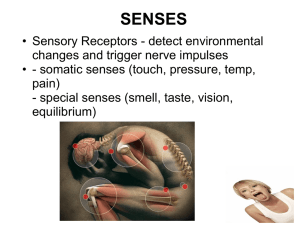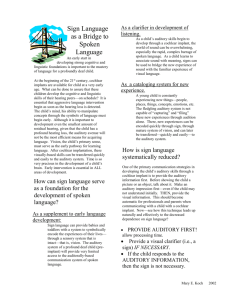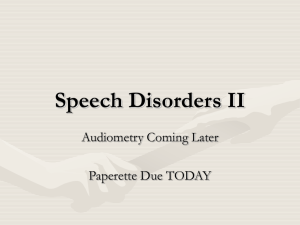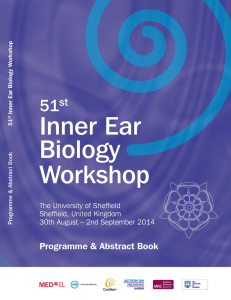THE EAR: Hearing and Balance
advertisement
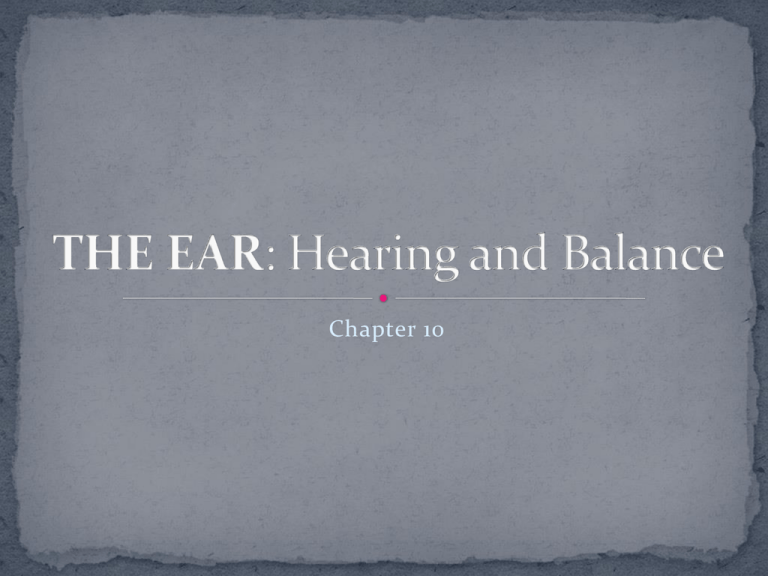
Chapter 10 1. Outer (external) 2. Middle hearing only 3. Inner (internal) - balance & hearing 1. 2. 3. 4. 5. 6. 7. 8. 9. 10. 11. Auricle (pinnae) External auditory meatus (auditory canal) Tympanic membrane Malleus (hammer) Incus (anvil) Stapes (stirrup) Oval Window Vestibule Cochlea (*Organ of Corti) Cochlear nerve Cerebrum 1. 2. 3. 4. 5. Sound waves enter the external auditory meatus. Waves of changing pressure cause the eardrum to reproduce vibrations coming from sound a wave source. Auditory ossicles amplify and transmit vibrations to end of stapes. Movement of stapes at oval window transmits vibrations to perilymph of cochlear duct. Vibrations pass through the vestibular membrane and enter endolymph of cochlear duct. 6. Different frequencies of vibration in endolymp stimulate different sets of receptor cells. 7. As a receptor cell depolarizes, its membrane becomes more permeable to calcium ions. 8. Inward diffusion of calcium ions causes vesicles at the base of the receptor cell to release neurotransmitters. 9. Neurotransmitter stimulates ends of nearby sensory neurons. 10. Sensory impulses are triggered on fibers of the cochlear branch of vestibulocochlear nerve. 11. Auditory cortex of the temporal lobe interprets sensory impulses. Decibels (dB): measure sound intensity Whisper 40dB Rock concert 120dB Normal conversation 60-70dB Jet plane 140dB Frequent or prolonged exposure to sounds above 85dB can damage hearing receptors and cause permanent hearing loss. Frequency: number of vibrations or sound waves per second Human: can detect sounds with a frequency of 20- 20,000 per minute Dog: 60-45,000 Rat: 650-60,000 Bat: 3,000-120,000 Static equilibrium: sense of position of the head, maintaining stability and posture when the head and body are still. (vestibule) Dynamic equilibrium: detect head and body motion and aid in maintain balance (semicircular canals) All of this information goes to the cerebellum Ear-popping: aids in equalizing pressure Your auditory tube is normally flattened and closed, but swallowing or yawning can open it to equalize pressure between the middle ear cavities with the atmospheric pressure. The eardrum will not vibrate unless pressure is equal. If there is unequal pressure, the eardrum bulges causing hearing difficulties and earaches. Otitis media: inflammation of the middle ear. Can be caused by sore throats in children. Myringotomy: implanting of a tiny tube to drain fluid & pus accumulation *Children have a more horizontal auditory tube* 2 types Conduction: temporary or permanent; results when something interferes with the conduction of sound vibrations to the fluid of the inner ear. Wax build-up Otosclerosis (fusion of the ossicles) Ruptured eardrum Otitis media Hearing aids: use skull bones to conduct sound vibrations to inner ear. Sensorineural: degeneration or damage to the receptor cells in Organ of Corti, cochlear nerve, or to neurons of the auditory cortex. Results from a problem of nervous system structures or by extended listening to excessively loud sounds. Hearing aids are less helpful Meniere’s disease: a pathological condition of the inner ear characterized by vertigo (sensation of spinning), tinnitus (ringing in the ears), and progressive loss of hearing. Presbycusis: occurs because of changes in the inner ear. Very common in older people. Otosclerosis: spongy bone formation that causes deafness by fixing the stapes to the oval window.
